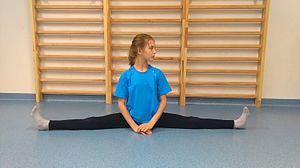Note: This is a project under development. The articles on this wiki are just being initiated and broadly incomplete. You can Help creating new pages.
Samakonasana
Samakonasana or A split (commonly referred to as splits or the splits) is a physical position in which the legs are in line with each other and extended in opposite directions. Splits are commonly performed in various athletic activities, including dance, figure skating, gymnastics, martial arts, contortionism, synchronized swimming, cheerleading and yoga. A person who has assumed a split position is said to be "in a split" or "doing the splits".
When executing a split, the lines defined by the inner thighs of the legs form an angle of approximately 180 degrees. This large angle significantly stretches, and thus demonstrates excellent flexibility of, the hamstring and iliopsoas muscles. Consequently, splits are often used as a stretching exercise to warm up and enhance the flexibility of leg muscles.
There are two general forms of splits:
Side splits are executed by extending the legs to the left and right of the torso. Side splits are called straddle splits (or middle splits) in dance and yoga, and may be referred to as Chinese splits in martial arts. Other names for side splits are box splits and center splits. Front splits are executed by extending one leg forward of, and the other leg to the rear of the torso. In dance, a front split is named according to the leg that is extended forward (e.g., the right leg is extended forward when executing a right split). In yoga a front split is known as Hanumanasana. Front splits require hyper-extension of the iliofemoral ligament, otherwise the majority of the range of motion must come from the front hip joint.
There are many variations of form and performance of splits, including:
- Oversplit, in which the angle between the legs exceeds 180 degrees.
- Suspended split, in which the body is static and supported only by the feet.
- Split leap or split jump is a split that is executed after leaping or jumping, respectively, while still in the air. In figure skating, split jumps are sometimes called Russian jumps. They can be done as an exercise.
- Standing split or vertical split, in which the leg lines are oriented vertically either to the side or to the front. This can also be an oversplit and a front oversplit with the back arched backwards, sometimes called a layout.[2]
- Twisting split is performed by transitioning from front split to side split, and then to the opposite front split.
- Martial arts split is a front split in which the back leg is rotated so the inside edge of the foot rests on the ground. It is more commonly named a "half split".
Problems
- A common problem encountered during a side split is pain in the hip joints. Usually, the reason for this is that the split is being performed improperly (the pelvis may need to be tilted forward).
- Another common problem encountered during splits (both front and side) is pain in the knees.
